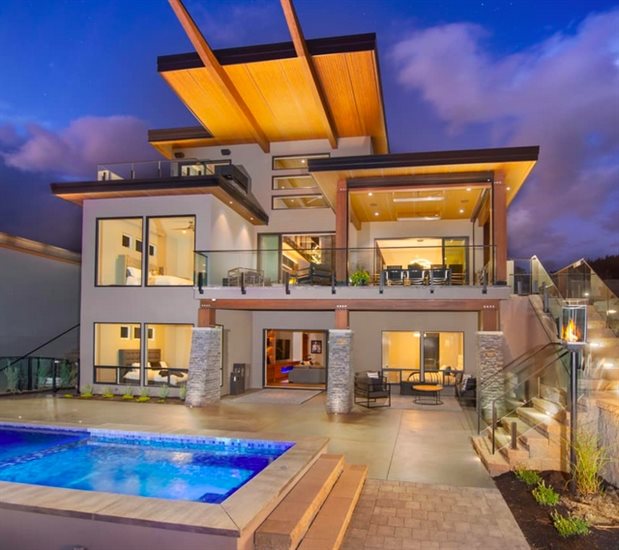A few reasons why new housing is so expensive in the Okanagan

As with other commodities, the price of new housing in the Okanagan is rising dramatically.
But you might be surprised at some of the things driving up those costs.
Certainly labour and supply chain issues are big factors but so are things like bureaucratic delays and high fees paid to local governments.
“There’s definitely a disconnect happening with things like appliances and shipping some fixtures,” Krista Paine vice-president of the Central Okanagan branch of the Canadian Home Builders’ Association and owner of Ian Paine Construction, told iNFOnews.ca.
“Appliances have been the biggest doozies for us over the last two years,” she said. “We’ve had houses that have been done for six months and we’re still waiting for appliances.”
A product ordered well in advance and given a delivery date can be delayed repeatedly.
That’s not so bad with things like fridges and dishwashers that are pretty standard sizes but wall ovens and stovetops are a problem, especially in the custom-built homes and renovations Ian Paine Construction specializes in.
“So many of the custom homes now are literally being designed around appliances, one way or another,” Paine said. “We were waiting for a cooktop for over a year and, finally, someone found an alternative that was the exact same cut-out hole. We got it installed and it’s shorter than the other one so it’s sunken in and looks goofy. It doesn’t look well done because everything was designed around the other cooktop.”
READ MORE: Kelowna not keeping up with demand for high-end penthouse condos
As she understands it, when COVID hit, the manufacturers cut back production and have yet to catch up to what’s turned out to be an increased demand.
“The fact that my sales rep from (an appliance store) doesn’t know either, it’s just shocking,” Paine said. “You would think by now they would have caught up but there are still some significant delays. We’re only ordering appliances that are in stock now. We’re not even bothering with the shipping because you can’t trust the timelines.”
The blame is being placed increased demand for product but also a worldwide shortage of tin and the semi-conductors that are now common in “smart appliances.”
According to TheConversation.com, it's also what it calls “shipping shenanigans.”
When the pandemic disrupted world trade, shipping containers got left in the wrong locations as ports were closed. Now, that disruption is still not sorted and there are backlogs at some major ports, causing the typical container to spend 20% longer in transit, it says.
The Conversation also points to “the human factor” where laid off workers shifted to other occupations. It uses Vietnam as an example where there was a mass exodus of workers back into rural areas that has yet to be reversed.
There are delays in other building materials but those are more predictable and manageable.
Roof trusses, for example, that are ordered from places like Rona or Home Hardware, used to take a few days to get built and delivered. Now it take a few weeks, just because of the sheer volume.
That can be managed is the building schedule, not like appliances that have such unpredictable delivery dates.
LABOUR
As with most other industries, there’s a shortage of workers in the construction sector, which means higher costs as well as delays.
“Because of labour shortages, potential employees increase their value and ask for more money per hour, knowing they’re hard to come by,” Paine said.
She’s used skilled trades subcontractors, like electricians and plumbers, for years and hasn’t found a problem there.
The shortage is more in the construction phase.
“Finding skilled journeymen or apprentices is so tough, there’re just so few of them out there available,” Paine said. “I know quite a few other builders who put an ad out for an employee and they’ll go two months without a resume being sent in. A few years ago, you would have 50 resumes on your first day.”
A few years ago, when she was building more standard homes, she was able to get the construction window down to six to eight months.
“I’d estimate, for all projects, you’re looking at a year and if you can button that up to 10 months you’re doing good,” Paine said, noting custom designed homes can take much longer.
Les Bellamy, owner of Bellamy Homes, noted that builders won’t guarantee prices for more than 30 days when quoting on work because the cost of materials can escalate so quickly.
That means, construction delays because of labour shortage, add to the cost of the final product.
STEP CODE
In 2017, the provincial government brought in the B.C. Energy Step Code that requires new homes be built with “net zero energy” requirements by 2032.
The five steps are to be phased-in but the City of Kelowna has made the third level a requirement now, jumping Step 2.
That means products, like more energy efficient windows, aren’t readily available from manufacturers which are still producing mostly at the Step 2 level.
“Right now, you’re having to upgrade so many things to hit your energy rating,” Paine said. “But, pretty soon, those things are going to be the common things so the prices will come down a little bit.”
READ MORE: Lower Mainland buyers flooding Okanagan’s new home market
MUNICIPAL FEES
Bellamy has built more than 300 homes in the Central Okanagan over the last few years.
Last year, at the behest of a customer, he tried his hand at rezoning and subdividing one lot into two, demolishing the existing house in order to build two rental properties.
The rezoning was approved quickly but the subdivision is taking longer.
“The concern I had is the cost,” Bellamy said. “I was really shocked that the rezoning cost was $45,000 from the City of Kelowna, rounded. And I thought that was it.”
When he went ahead with the subdivision process he was told he would have to pay another $30,000 in development cost charges that have to be paid for off site servicing for things like parks and major road improvements.
He thought the $45,000 covered that, only to learn that money was destined for possible future upgrades to the road he was building on, for things like future sidewalks, street lights, etc.
Then there was another $35,000 to $38,000 for sewer and water lines to the second lot.
“That one, I don’t argue with because they’ve got to put in a new water line and they’ve got to put in a new sewer line and that costs money and they have to dig up the road and repave on it and so on,” Bellamy said. “That’s actually a reasonable cost for what I’m getting. It’s the $75,000 to create two rental properties. That just seems astonishing to me.”
In the end, along with things like architectural drawings and title searches (which the owner had to pay him to do then pay a lawyer to do the same work and sign off on it), there’s an added cost of more than $100,000 to the project. That doesn’t include the cost of land and construction.
“That’s not housing affordability at all,” Bellamy said. "That’s an extra $50,000 per house on the mortgage.”
LOCATION
Both the cities of Kelowna and West Kelowna take about four to six weeks to process building permits, Paine said.
“The City of Kelowna is very efficient,” Bellamy said. “I’m very happy with how quickly they put out building permits.”
That’s not the case with Lake Country, where he’s been waiting for more than a year for the four building permits he has in process.
While the District of Lake Country says it takes an average of four to five weeks to process a simple building permit, that’s not the experience of Bellamy and some other builders.
“The last few projects I’ve done in Lake Country were for renovations,” Paine said. “That took about two months to get the permits approved. The renovation timeline of six to 8 weeks was ridiculous where Kelowna will take a week.”
As a member of the Homebuilders Association board she hears from other builders who have concerns with the permitting process in Lake Country.
One of the key factors in the length of time it takes to get a permit is “capacity” based on the volume of applications and staffing levels, Jared Kassel, director of planning and development, said in an email to iNFOnews.ca, citing a 22% population growth rate from 2016-21 along with the subsequent increased volume of applications.
“During this period of incredible record-breaking activity, our internal resources were strained,” he added. “We are currently working to fill our staff complement and to find efficiencies and process improvements within our organization.”
“We just got our first permit,” Bellamy said. “It took one year. The next one coming up is going to be close to 14 months and the next one after that, they’re telling me that it’s going to be another six months before they even open my file, and I applied in November.”
Lake Country has created an appointment system to speed up the process but Bellamy refers to that as “smoke and mirrors.”
Rather than sit on his application for six to nine months before they have time to even look at it, they now schedule that initial appointment months down the road, resulting in a shorter time to actually process the application but just as long to get through the process, he said.
That process is complicated by the fact that, unlike Kelowna, Lake Country requires development permits for single-family homes, further complicating and dragging out the timelines.
“My projects, because they’re held up for a year or more on permitting, we’re having to be repricing,” Bellamy said. “The first one, we just got the last bit of pricing in this week. It’s a $220,000 increase on the cost of construction. It was $1.6 million last year. Now it’s $220,000 more. That’s a big number.”
To contact a reporter for this story, email Rob Munro or call 250-808-0143 or email the editor. You can also submit photos, videos or news tips to the newsroom and be entered to win a monthly prize draw.
We welcome your comments and opinions on our stories but play nice. We won't censor or delete comments unless they contain off-topic statements or links, unnecessary vulgarity, false facts, spam or obviously fake profiles. If you have any concerns about what you see in comments, email the editor in the link above.




